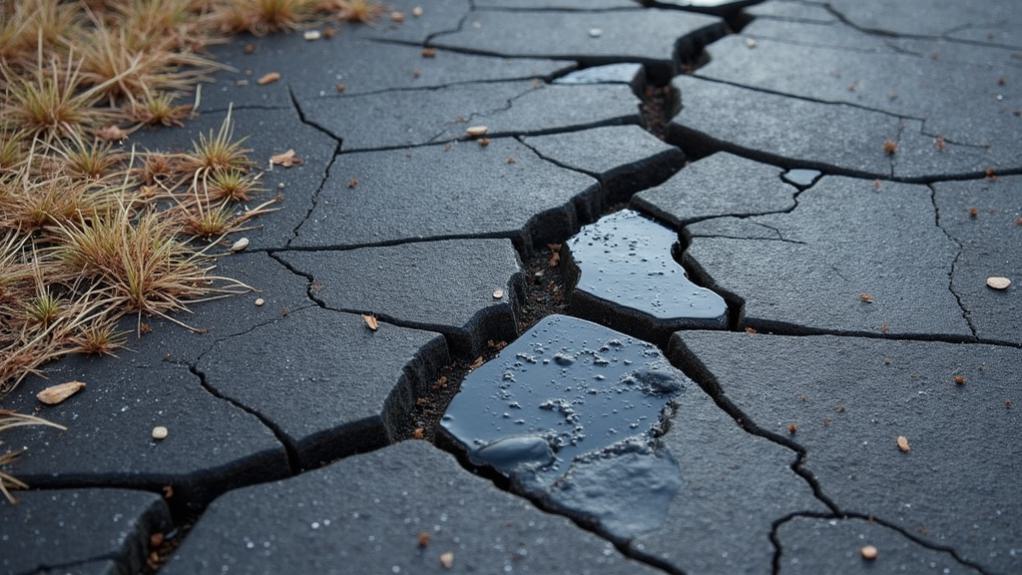Asphalt cracks primarily due to environmental factors, poor installation, and traffic loads. Water infiltration erodes the supporting base, while freeze-thaw cycles exacerbate damage. Vegetation can disrupt the surface, creating cracks and weakening structural integrity. Hydrocarbon spills also corrode the asphalt binder, leading to surface breakdown.
Additionally, fluctuating temperatures cause expansion and contraction, paving the way for cracks. Heavy vehicle traffic accelerates wear, resulting in fatigue cracking. Regular maintenance and effective drainage are essential for extending asphalt life and preventing deterioration. Understanding these factors can help you tackle asphalt issues effectively, revealing more insights into prevention and repair.
Key Takeaways
- Water infiltration destabilizes asphalt by eroding its gravel base, leading to cracks and potholes, especially in areas with poor drainage.
- Tree roots can invade asphalt, causing structural damage and allowing water to seep in through cracks, exacerbating deterioration.
- Hydrocarbon spills weaken asphalt surfaces, disrupting the binder and leading to discoloration and raveling if not addressed promptly.
- Poor installation practices, such as inadequate compaction and low-quality materials, can create weak spots that are prone to cracking.
- Extreme weather fluctuations, including freeze-thaw cycles and prolonged sun exposure, contribute to asphalt brittleness and cracking over time.
Water Damage Effects

Water infiltration markedly impacts asphalt integrity, primarily by eroding the underlying gravel and sand base. When moisture accumulates beneath the surface, it destabilizes the asphalt, leading to cracks and potholes. This is especially true when pooling water collects on uneven surfaces, as the weight of traffic combined with moisture creates a hydraulicing effect, compounding asphalt damage.
Regular sealcoating can help mitigate these issues by providing a protective barrier against water and enhancing aesthetic appeal. Insufficient drainage systems exacerbate this issue, allowing moisture accumulation to persist. As water continues to infiltrate, it causes the asphalt to shift and eventually break down, leading to structural failure.
Moreover, freeze and thaw cycles play a critical role in this deterioration. Water trapped within existing cracks expands when frozen and contracts as it thaws, causing further damage to the asphalt surface over time.
To mitigate these effects, regular maintenance and effective drainage solutions are essential. By addressing water infiltration promptly and maintaining drainage systems, you can greatly extend the lifespan of your asphalt surfaces.
Timely repairs not only prevent moisture-related issues but also enhance the overall integrity of the pavement, ensuring it withstands the rigors of traffic and environmental conditions.
Impact of Vegetation
While asphalt surfaces are designed to withstand various environmental stresses, the impact of vegetation can considerably undermine their structural integrity. Vegetation growth, particularly from trees and shrubs, often infiltrates asphalt surfaces, leading to significant damage. This is especially prevalent in semi-rural areas where expansive driveways are common. Tree roots can disrupt the asphalt, causing edge cracking, a phenomenon where cracks form near the pavement edges due to insufficient lateral support.
Moreover, vegetation growth through existing cracks can create pathways for water infiltration, further deteriorating the asphalt and increasing the risk of potholes. To combat these issues, careful landscaping planning is essential. You should consider the placement of trees and shrubs to minimize the risk of invasive roots affecting your asphalt surfaces.
Here’s a summary of the impact of vegetation:
| Vegetation Impact | Description | Mitigation Strategy |
|---|---|---|
| Tree Roots | Infiltration causes structural damage | Monitor root growth and adjust landscaping |
| Water Infiltration | Cracks allow water to penetrate | Seal cracks promptly to prevent further damage |
| Edge Cracking | Lack of lateral support from vegetation | Maintain a safe distance from edges |
| Asphalt Deterioration | Increased risk of potholes | Regular inspections and maintenance |
| Preventive Measures | Planning landscaping to avoid invasive roots | Design with asphalt longevity in mind |
Hydrocarbon Spills

Hydrocarbon spills can wreak havoc on asphalt surfaces, leading to severe structural damage if not addressed promptly. Spills from petrol, diesel, and oil greatly corrode the asphalt, increasing its susceptibility to cracks. The chemical composition of these hydrocarbons can disrupt the binder within the asphalt, weakening its structural integrity.
Regular maintenance services, such as asphalt repair and seal coating, play an essential role in mitigating the effects of these spills.
Early intervention is essential. Petrol can cause the asphalt surface to harden, while diesel fuel penetrates deeper, often necessitating complete replacement of the affected area. Regular monitoring for hydrocarbon spills is important, as untreated contamination can compromise the asphalt, resulting in costly repairs down the line.
You may notice discoloration and surface raveling, which signal underlying damage that requires professional assessment. These signs indicate that the structure isn’t only at risk of cracking but may already be compromised.
To mitigate the damaging effects of hydrocarbon spills, proper maintenance practices are crucial. Prompt spill clean-up and the application of sealants can help preserve the asphalt surface, preventing further degradation.
Installation Quality Issues
The integrity of asphalt surfaces isn’t only compromised by external factors like hydrocarbon spills but also by the quality of installation. Poor asphalt installation can drastically shorten the lifespan of your pavement, often stemming from DIY projects that neglect proper techniques and materials.
Quality installation hinges on adequate compaction and layering; without sufficient compaction, weak spots emerge, making the surface susceptible to cracking and deterioration. Investing in expert asphalt paving services not only guarantees proper techniques are employed but also uses high-quality materials that enhance durability.
Additionally, using low-quality asphalt mixes can result in slippage cracking, where layers fail to bond properly, leading to structural failures. Inadequate joint construction also contributes to longitudinal cracking, as poorly formed joints allow for asphalt shrinkage and movement, ultimately resulting in visible cracks.
To mitigate these installation quality issues, consider investing in professional services, like those offered by NK Asphalt. High-quality workmanship not only addresses these concerns effectively but also minimizes the risk of installation-related damage.
Weather-Related Factors

Understanding how weather-related factors contribute to asphalt cracking is vital for maintaining your pavement’s integrity. These factors can greatly affect the longevity of your asphalt surface.
- Extreme temperature fluctuations cause asphalt to expand when heated and contract in cooler conditions, creating stress that leads to cracks.
- Prolonged sun exposure in dry climates breaks down the oil and tar in asphalt, resulting in brittleness and increased susceptibility to damage.
- Moisture from rain and snow can weaken the binders in asphalt, especially during freeze and thaw cycles, where water expands as it freezes and exacerbates cracking.
- Common weather-related cracks include block, longitudinal, and transverse cracking, which can occur in areas with minimal traffic, highlighting the importance of environmental conditions.
- Proper drainage is essential; insufficient drainage can lead to surface puddles that accelerate deterioration and contribute to cracking.
Aging and Wear
With time, asphalt surfaces inevitably face aging and wear, impacting their structural integrity and performance. Although asphalt typically has a lifespan exceeding 20 years, aging can lead to a decline in its resilience and strength.
Regular wear from traffic, particularly heavy vehicles, accelerates this deterioration, causing asphalt cracks and surface raveling. The aging process is worsened by environmental factors. Ultraviolet (UV) exposure depletes the oil and tar within the asphalt, making it brittle and more prone to cracking.
This brittleness compromises the surface, leading to further degradation. Additionally, moisture infiltration through existing cracks can exacerbate aging effects, causing potholes and instability within the asphalt structure.
To combat these issues, proactive maintenance is essential. Implementing sealcoating every 2-3 years can greatly extend the life of aging asphalt, preventing substantial damage from escalating.
Drainage Problems

Effective drainage is essential for preserving the longevity and integrity of asphalt surfaces. When drainage problems arise, water pooling becomes a considerable issue. Accumulated moisture can infiltrate the asphalt layer, leading to various complications.
If you’re not vigilant, this can result in:
- Increased risk of cracks and potholes
- Weakened low-grade pavement over time
- Erosion of the gravel and sand base
- Structural instability beneath the asphalt
- Accelerated deterioration from water pressure
Puddles on asphalt surfaces exert pressure that exacerbates any existing cracks, causing further damage. As water seeps into these cracks, it compromises the structural integrity of the pavement, leading to more extensive repairs down the line.
Insufficient drainage systems not only allow water to accumulate but also contribute to the erosion of the underlying support, markedly increasing the likelihood of cracks and structural issues.
To maintain the integrity of your asphalt surfaces, confirm that effective drainage is implemented and regularly maintained. This proactive approach will help you mitigate the risk of costly repairs and extend the lifespan of your pavement.
Traffic Load Impacts
Heavy vehicles, such as trucks and buses, exert significant pressure on asphalt surfaces, making traffic load impacts a critical concern for pavement longevity. The phenomenon of traffic loading primarily leads to fatigue cracking, particularly due to frequent heavy vehicle use.
As the weight of these vehicles bears down, it creates stress on the asphalt, exacerbating wear and increasing the likelihood of surface deterioration over time. You may notice interconnected alligator-like cracks forming on the surface, a clear indicator of fatigue cracking.
While the regular movement of heavy vehicles can help distribute stress and mitigate some cracking, prolonged exposure to excessive loads inevitably results in damage. A well-designed pavement structure can withstand certain traffic loads; however, exceeding these limits can dramatically shorten its lifespan.
Moreover, high-quality drainage beneath the asphalt is critical. Insufficient drainage exacerbates the effects of heavy traffic loads, leading to accelerated damage.
Understanding these aspects of traffic load impacts is essential in maintaining asphalt integrity and minimizing costly repairs. By recognizing the relationship between heavy vehicle use and pavement deterioration, you can make informed decisions regarding maintenance and usage.
Temperature Fluctuations

Asphalt surfaces are highly sensitive to temperature fluctuations, which can lead to significant structural damage over time. In regions with extreme climates, the constant expansion and contraction of asphalt pavement due to temperature changes can result in cracks. The sun’s heat dries out asphalt, making it brittle, and sudden drops in temperature can further exacerbate this issue.
Consider the following impacts of temperature fluctuations:
- Expansion and contraction: Continuous cycles can weaken the asphalt.
- Freeze and thaw cycles: Moisture infiltrating cracks can freeze, expand, and create new fissures.
- Brittleness: Dried-out asphalt is more susceptible to cracking.
- Types of cracks: You may notice transverse and block cracking as indicators of damage.
- Long-term effects: Repeated fluctuations can compromise the asphalt’s structural integrity.
To mitigate these effects, regular maintenance is essential. Sealcoating acts as a protective barrier, preventing moisture penetration and reducing the risk of freeze and thaw damage.
Maintenance Importance
Maintaining your asphalt surfaces is crucial for guaranteeing their longevity and functionality. Regular inspections play a critical role in identifying issues early, allowing you to address small cracks before they evolve into larger, more costly repairs.
The maintenance importance can’t be overstated; proactive measures greatly extend the lifespan of your asphalt.
Sealcoating every 2-3 years provides a protective barrier against harmful UV exposure and moisture damage, both of which contribute to deterioration. Additionally, implementing proper drainage solutions helps prevent moisture accumulation, a key factor in maintaining the integrity of your asphalt.
When water infiltrates cracks, it can lead to more extensive damage and increased repair costs.
Moreover, effective weed control is essential, as it reduces the likelihood of water seeping through cracks and causing considerable harm. By promptly addressing minor issues and conducting routine maintenance, you not only preserve the quality of your asphalt but also minimize overall maintenance expenses.
Conclusion
In summary, understanding the various factors that lead to asphalt cracking is essential for maintaining its integrity. Just as a chain is only as strong as its weakest link, your pavement’s durability relies on addressing issues like water damage, vegetation, and temperature fluctuations. By prioritizing quality installation and regular maintenance, you can greatly extend the lifespan of your asphalt surfaces. Don’t wait for cracks to appear; proactive measures will save you time and money in the long run.



